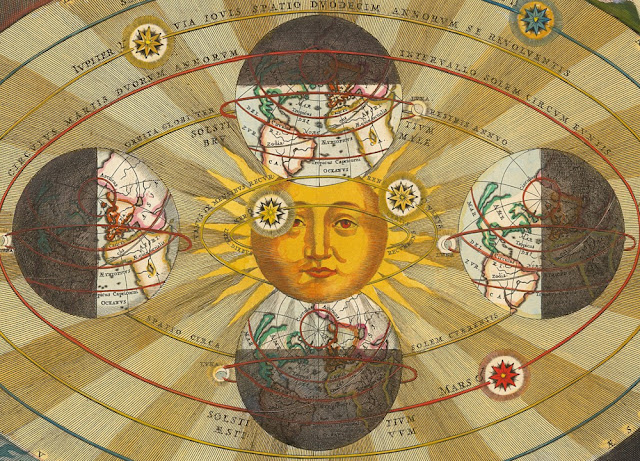1.
The pre-Copernican
Theory
Before
Nicolaus Copernicus presented his heliocentric theory in 1543, the prevailing
view of the universe was that the Earth was the center of the universe [7][6].
This pre-Copernicus theory was based on the Ptolemaic system, which had
remained Europe's accepted cosmology for over a thousand years [5]. In this
system, the planets orbited the Earth rather than the sun [3]. However, by
Copernicus' day, astronomical evidence had thrown some of his theories into
confusion [2][5]. Copernicus recognized that many people had suggested the
Earth moved, including the Greek philosopher Cicero in the fourth century B.C [5].
He also acknowledged that Aristarchus of Samos had published writings
containing references that were cited by his contemporaries [5]. Consequently,
Copernicus set out to develop his own model of the solar system, in which the
Earth and other planets move in circles around the fixed Sun [4]. This
revolutionary theory, outlined in his major astronomical work "On theRevolutions of the Heavenly Spheres," challenged the pre-Copernican view
of the universe and eventually replaced it [1].
Copernicus explanation
Nicolaus Copernicus was a Polish astronomer and mathematician who is credited with
initiating the Scientific Revolution. He proposed a heliocentric model of the
universe in which the Sun is at the center, and the planets revolve around the
Sun. This was in contrast to the geocentric model, which had been accepted by
the Church for more than a thousand years [8]. Copernicus published his theory
in his book "On the Revolutions of the Heavenly Spheres" [9], which
was a groundbreaking work that went against the commonly held belief that the
Earth was the center of the universe. In this model, Copernicus argued that the
Earth spins on its axis daily [5][9] and takes one year to orbit the sun,
during which it wobbles gradually on its axis [5]. This explained the precession
of the equinoxes [5] and the retrograde motion of the planets [10]. His ideas
were met with strong resistance from the Church, who saw them as blasphemous
(offensive to God or religion) [9]. It took nearly a hundred years for Copernicus' theory to be accepted, and even then it was only due to the work of
Galileo Galilei, who was under house arrest for claiming that the Earth orbited
the Sun [3]. Ultimately, Copernicus' heliocentric model became the foundation
of modern astronomy and provided the basis for further study and exploration of
the universe [2].
Fig 2: Heliocentric model
Image Source: https://www.wondriumdaily.com/the-heliocentric-theory-nicolaus-copernicus-and-galileo-galilei/
Isaac Newton's contributions to the spin theory are numerous and varied. His
classical mechanics laws of motion and gravity provided a framework for
studying motion, and have been used to understand the motion of objects in the
universe [11]. He also developed a circular diagram to demonstrate the primary
colors and may have used a spinning disc to demonstrate the principles of light
[11]. This disc was divided into sectors and filled with the primary colors
[12], which Newton demonstrated was a compound of the primary colors [13]. Upon
quantization, the adjoined orbits of the Poincare group turn into irreducible
unitary representations, and the spin gets quantized in the same way as angular momentum gets quantized when quantizing its representation on the sphere [13].
This is demonstrated in the familiar Newton's cradle, which is a series of
swinging spheres that illustrate the concept of conservation of momentum and
energy [11]. Thus, Isaac Newton's contributions to the spin theory have been
invaluable to the field of physics, and his discoveries continue to be used to
understand the motion of objects in the universe.
Sources
[1] https://www.uu.edu/dept/physics/scienceguys/2004Jan.cfm
[2] https://www.space.com/15684-nicolaus-copernicus.html
[3] https://plato.stanford.edu/entries/copernicus/
[5] https://www.history.com/topics/inventions/nicolaus-copernicus
[6] https://en.wikipedia.org/wiki/Copernican_heliocentrism
[7] https://earthobservatory.nasa.gov/features/OrbitsHistory
[8] https://www.nmspacemuseum.org/inductee/nicolaus-copernicus/
[9] https://www.worldhistory.org/Nicolaus_Copernicus/
[10] https://www.famousscientists.org/nicolaus-copernicus/
[11] https://www.scirp.org/html/1-7500374_17097.htm






0 Comments